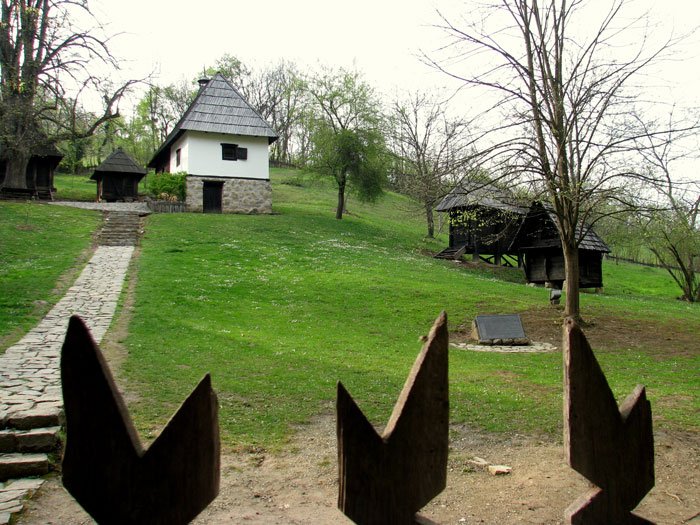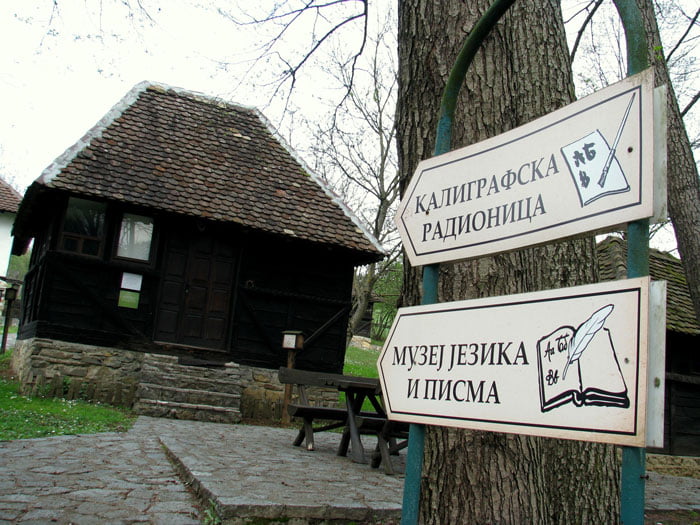
If you need a freelance travel writer or you would like to see your country, city, flight, etc., presented on the blog, drop me an email.
Find our more on Freelance Travel Writer page.
FROM BELGRADE: about 140 km
FROM NIŠ: about 375 km
If you are driving from Belgrade, the easiest way to reach Loznica Serbia, is to take the highway via Ruma or go through Obrenovac and Šabac. Coming from Niš would mean either reaching Belgrade first or traveling through Kraljevo and Užice—the first option being faster because of the highway toward the capital.

Loznica Serbia
Located beneath the Gučevo mountain on the right bank of the Drina River, Loznica is considered the cultural and tourism center of the Podrinje region. The municipality has a population of around 80,000 people living in 54 settlements, and the town itself sits at an altitude of 142 meters.
During the rule of the ancient Romans, this area was part of the Dalmatia province. The first settlement was called the station “15 miles,” and the most notable location was the so-called Genzis. The town’s name likely derives from the word “vine” (loza in Serbian), as vineyards have been cultivated here since the 3rd century. Loznica was first mentioned in King Milutin’s document when the nearby Tronoša Monastery was erected in 1317. It became part of the Serbian state during the reign of Miloš Obrenović in 1833.
When you enter the town, you’ll be surprised by how lively it is. I first visited Loznica a few years ago, but due to bad weather and ongoing construction in the town center, my impression wasn’t the best. This time, however, the trees were just beginning to blossom, people were out enjoying the sunny day, and the traffic was bustling. Parks were full of visitors, and finding a parking spot was quite a challenge (you pay either by the hour or a daily fee). But once you get past all that, you step into clean streets lined with charming façades.

Mr. Zoran from the Tourism Organization of Loznica shared stories about the town, explaining how it once consisted of Upper and Lower Port stations in the 19th century. He also told me how the Stira River, which flows through the modern center, was once very different. Today, the river flows between stone-built banks, bringing a refreshing breeze and reminding us that the Drina River is not far away.
Our walk began near the monument of Vuk Karadžić, an exceptionally important historical figure born in a nearby village. The area was once popular among aristocrats, traces of whom can still be seen in the surrounding architecture.

The Jadar Museum, with its pink façade and distinctive cone on top, should definitely be one of your stops. Opened in 1987, it houses a rich ethnological exhibition. It overlooks a vast park featuring the statue of Jovan Cvijić, another prominent Loznica native. (Born in 1865, he is considered the father of Serbian geography. The town dedicated this park and a promenade to him, which hosts the Cvijić’s Days Festival every October.) Nearby, you’ll find the recognizable orange building of “Vukov dom kulture” (Vuk’s Culture Center). The land where it was built once belonged to Staka Pejić from Lesnica village, who donated it to the town. The center houses the town theater, cinema, gallery, and the Folk Dance Group Vuk Karadžić.

Further up the Jovan Cvijić Promenade is the legacy of the renowned artist Mića Popović, also from Loznica. The gallery showcases works by him and his wife, Vera Božičković. The gallery is housed in one of the most representative 19th-century buildings, and Mića himself attended its opening ceremony in 1989. Every June, the festival of Mića’s and Vera’s Days takes place here.

Strolling along the pedestrian street, you’ll come across numerous café terraces and shops, with the Tourism Organization of Loznica office at the end. (Be sure to stop by for souvenirs featuring local motifs.) On the right, a hill is home to a lovely school building and the town’s church. The small square nearby features a statue of Filip Višnjić by Drinka Pavlović. Mr. Zoran shared how the Virgin Mary Church stands on the site of the old fortress, where the famous Battle of Loznica occurred in 1810. This is also where the military leader Anta Bogićević is buried. Zoran reminisced about playing here as a boy, slipping into the hollow trunks of ancient trees.

Tršić Serbia
Just 7 km from Loznica lies the village of Tršić Serbia, the birthplace of Vuk Stefanović Karadžić (1787–1864), the philologist and linguist who reformed the Serbian language. This open-air museum, with the small Žeravija River flowing through it, is a treasure trove of history. It features the Language Museum, a gallery, traditional guesthouses, a calligraphy workshop, Vuk’s Festival Museum, and his Memorial House. Tršić is particularly lively during the Vukov Sabor festival in September and the Đački Vukov Sabor in May. It’s also a favorite weekend getaway for locals.

At the entrance to Vuk’s Memorial House, an inscription quotes him as saying that he was born and raised in Serbia and that, therefore, Serbia is the most beautiful country in the world, “with no better place than Tršić.” The current house was built in 1933 on the site of the original one and decorated based on villagers’ testimonials. Marking the centenary of his death, the complex was restored in 1964, with further additions in 1987 to accommodate festival activities.

Rushing to capture as many photos as possible, I stopped at one of the traditional wooden cottages, which once served as a watermill. These houses were originally brought here from surrounding villages. For lunch, we enjoyed a traditional meal at a local restaurant, ending with delicious homemade “orasnice” cookies served with coffee. (Mr. Zoran even shared the recipe, claiming, “It never fails.”)
We also visited the Educational Cultural Center Vuk Karadžić, opened in 2018, which hosts excursions, workshops, and conferences. With 40 rooms and 144 beds, the center is adorned with artwork donated by participants in its workshops. Modern facilities include conference halls equipped with laptops, projectors, and interactive boards. (What would Vuk say today if he had known—while fighting to ensure every letter in the Serbian language had a single sound, striving to bring the alphabet and reading closer to the Serbian people—that his village would one day have projectors and be connected to the rest of the world with high-speed internet!)

“You just have to admire it,” said Mr. Zoran. “For a man from such a small village, with fragile health, to achieve so much—he truly is a giant of our history!”
It’s no surprise that Loznica, Serbia, proudly celebrates Vuk’s legacy, reminding visitors that this vibrant town is special, “at least for a letter.”

Tronoša Monastery
Located 10 km from Tršić and 17 km from Loznica, Serbia, the Tronoša Monastery is the endowment of Serbian King Dragutin. His Hungarian wife, Katarina (or Katelina), erected it in 1317. Within the monastery complex, there is an intriguing fountain dedicated to the nine Jugović brothers who fought in the Battle of Kosovo in 1389.

As we drove towards the monastery, we discussed Vuk Karadžić and how he attended school here. His father, however, doubted Vuk would learn much, given that children often spent their time guarding the monastery’s sheep. Our first stop was the famous fountain. According to legend, the Jugović brothers stopped at this refreshing spring on their way to Kosovo. Later, the fountain was built in their honor and decorated with an authentic mosaic. The water flows during the day and is bottled at night for the nearby Tronoša bottled water company.

The monastery was destroyed after the Battle of Kosovo and remained in ruins until 1599. After its reconstruction, it was burned to the ground again in the 19th century by the Turks. Serbian ruler Miloš Obrenović oversaw its second restoration. During World War I, the monastery served as a refuge for wounded Serbian soldiers. Its treasures, including the Tronoša Script—one of the first written accounts of Serbian history—were taken by the Austrians to Vienna.
A unique tradition here is the making of the so-called plowman’s candles. Each year, before Easter, people from nearby villages donate money to buy pure candle wax. Four days before Easter, two enormous candles are crafted and brought first to the Jugović Fountain, then to the monastery. These candles, each 1.5 meters tall and weighing 50 kilograms, burn throughout the year on major holidays. Any leftover wax is used for the following year’s candles.

Banja Koviljača Serbia
Banja Koviljača is one of the oldest healing spas in Serbia. Its thermal mineral water and peloid healing mud are effective in treating rheumatic conditions, herniated discs, osteoporosis, obesity, sterility, and various skin diseases. The Special Rehabilitation Hospital also features a dedicated section for children—the first of its kind in Serbia.
The Banja Koviljača park spans 40 hectares, with the Kur-salon as its most striking building. Opened in 1932 by King Aleksandar Karađorđević, the spa complex includes King Peter I’s sulfur bath, a special mud bath, and spa villas named Herzegovina, Dalmatia, Bosnia, Koviljača, and others. The medical premises also house a wellness center with pools, a sauna, a solarium, massage treatments, and the King’s Bath.

The first thing you’ll notice here is the expansive park, with a fountain at its center, surrounded by colorful flowers, majestic trees, and charming historic buildings. The Kur-salon, recently restored and reopened, is where royal balls were once held. It also housed a renowned casino. Designed to resemble Vienna’s Kur-salon, its name derives from the Latin word cura, meaning healing, health care, or recovery. Visiting the Kur-salon is a must on any “things to do in Loznica Serbia” list.

The spa’s name likely originates from either a noblewoman named Koviljka or the fairy grass (kovilje) that once grew abundantly in the area. A charming legend explains how the healing spring was discovered: a wounded horse left behind by a caravan miraculously recovered after resting in the nearby mud.

It is believed that ancient Romans may have used the spring’s healing properties, as they often built thermal baths across their empire. However, there is no concrete evidence of such baths here. Some speculate that the Drina River once overflowed its banks, hiding the spring and making it inaccessible. Turks began utilizing the water in the 17th century, but it wasn’t until two centuries later, under Serbian rule, that the spa entered its golden age. Previously nicknamed the “Smelly Spa” due to the sulfur water, it became known as the “King’s Spa” during this period. (In the spa, you’ll find lovely accommodations, with cozy rooms and villas to suit every budget. Click the link to check out one of them.)
“And now, we’ll ascend from the city at 142 meters above sea level, through Banja Koviljača, to 779 meters,” Mr. Zoran announces.

Gučevo Mountain
The highest peak of Gučevo Mountain is Crni Vrh, standing at 779 meters, where a memorial monument was erected in honor of WWI soldiers. This site marks the location of the so-called “battle beneath the clouds,” fought in 1914, where Serbian and Austrian soldiers were laid to rest together. The monument, built in 1929, commemorates a battle that lasted for an astounding 55 days.
In addition to its historical significance, Gučevo is renowned for its excellent conditions for sports, recreation, and excursions. It attracts mountaineers, cyclists, bikers, extreme sports enthusiasts, and paragliders.

The drive toward the highest point through the dense beech forest is an experience in itself. Upon reaching the summit, it becomes clear why Gučevo is a favorite spot for paragliding. Although a light mist hindered us from capturing perfect photos of the stunning panorama, the view was still breathtaking! From the top, you can see Loznica Serbia emerging to the right, with the Drina River gracefully winding its way through the landscape.
Mr. Zoran pointed out our next destination, down there by the river. Time for a break!

Ethno village Sunčana Reka (“Sunny River” in English) sprawls across 7 hectares and offers a delightful blend of activities and attractions. There are horses and other animals, a small amusement park, a museum area dedicated to the history of the Drina River, traditional houses available for rent, a restaurant, sports fields, and more. (I even stumbled upon a small cottage named Danijela—as it was meant for me!) Several well-known Serbian TV series were filmed here, adding a touch of fame to this charming village.
Lovers of traditional ambiance and cuisine will be more than delighted. Here’s the link if you’d like to book your stay right at Sunčana Reka.
As the clouds began to gather, we decided to have lunch indoors. Over the meal, we lamented the lack of time, as I hadn’t yet explored the nearby Cer Mountain, the village of Tekeriš, Badanja Spa, the monastery in Čokešina, or Budimlija. It was also too early in the season to enjoy the Drina fully. I was told that the most popular beach, located a few kilometers away near Banja Koviljača, hosts thousands of visitors during the summer.
So, next time I visit Loznica Serbia, I’ll be sitting outdoors by the Drina River, enjoying the serenity. And, of course, I’ll bring that delicious cake I discovered here—the one made with halva!
Next from Serbia: ACTIVE HOLIDAY IN TARA SERBIA
The full THINGS TO DO IN SERBIA section
PIN IT FOR LATER:

If you need a freelance travel writer or you would like to see your country, city, flight, etc., presented on the blog, drop me an email.
Find our more on Freelance Travel Writer page.
I am looking forward to working with you.




20 responses
I love the architecture here especially the types of homes and natural materials that are being used, lovely and the tour was spectacular. Thanks for taking me to a corner of this world I’ve never been to.
You probably refer to Trsic village. Yes, those are authentic old houses used in surrounding villages and gathered here afterwards for complex purposes.
Thank you, so glad you liked the post.
This is so funny. Although I am coming from neighbouring Croatia, this the first time I have heard of Loznica. In fact, while reading your post I was searching Google Maps to find out where exactly Loznica is. The town looks absolutely charming, picturesque and idyllic. The scenic countryside, traditional wooden cottages and the mill look so impressive!
Pozdrav iz Hrvatske
Oh, thank you so much for your interest. 🙂
I know the feeling when discovering a new place even though I think I’m familiar with the country. Even more so when it comes to neighboring countries, right!
So glad you like the post. 🙂
Lep pozdrav i od mene, iz Beograda. <3
I guess all the memorials and references to Vuk Karadzic show just how important language is. I like this small city and all the quaint buildings in the surrounding area.
Thank you. So true, Vuk Karadzic was a major figure for the language reform of the whole region. You can still hear people in Balkans saying their languages are ‘the easiest to read’. 🙂
I’ve never heard about Loznica, in Serbia. It seems like a nice place to visit if you are in Belgrade. Your post gives a lot of detailed information about getting there from Belgrade and what to see in this area, so I’ll bookmark it for future reference. We are planning a big Balkan road trip next year, so I’ll make this part of the itinerary.
So glad you’ll be coming to Balkans.
If you need more info on Serbia, feel free to browse around the Weekend in Serbia section on the blog. There are so many things not to be missed. 🙂
The town looks so charming and picturesque. I have never heard of Loznica before. The cute cottages and Mills give such a calm impression. I would love to spend some time here.
It’s even more beautiful during summer. I took these photos this April. 🙂
Loznica seems like such a beautiful place. It’s hard to imagine so much violence there. The Battle Beneath the Clouds even sounds beautiful, but I am sure that fighting for 55 days left plenty of soldiers in the cemetery on both sides.
I know what you mean. When we hear about events as such, it sounds almost romantic, even though I believe that things were pretty tough for those 1914 soldiers on both sides.
Thank you! <3
Wow, so many great things to see, loving the architecture. I could go for some homemade orasnice cookies!
I can get you a recipe if you’re interested. They are very easy to make and go extremely well with tea or coffee. 😉
We haven’t been to Serbia so we haven’t heard of Loznica before. It seems to a city full of history to explore. Ethno village sounds like an interesting place to visit!
Sure. If you are into traditional things, ethno village would be just the place to visit. When it comes to history, almost the whole Serbia has something to offer in regards of monuments and memorial centers. Thank you, Cat! 🙂
Just read a post on Belgrade and you say this is a drive away. All the more reason to get there soon now. Loved the quaint little homes, the history here and more importantly, there seems to be a vibe that makes you feel serene. Thanks for sharing this one.
Yes, it’s only 140 km from Belgrade, so it’s not that hard to plan a visit to Loznica when coming to Serbian capital. So glad you find it interesting, thanks. 🙂
This seemed like a peaceful place to visit. The like the aura of the place. Hope to visit one day 🙂
There’s something for everyone here – a city, but also some lavish nature nearby. 🙂